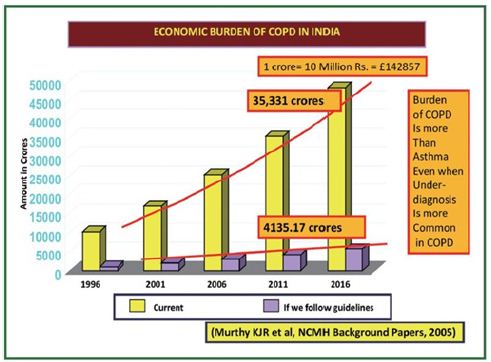Impact Factor : 0.548
- NLM ID: 101723284
- OCoLC: 999826537
- LCCN: 2017202541
B Sasirekha* and B Sara
Received: January 03, 2018; Published: January 10, 2018
Corresponding author: Mrs. B. Sasirekha, Msc [Nursing], Ph.D, Rani Meyyammai College of Nursing, Annamalai University, Chidambaram, Tamil Nadu, India
DOI: 10.26717/BJSTR.2018.02.000650
COPD is one of several chronic diseases that are becoming increasingly problematic worldwide. Low- and middle-income countries already shoulder much of the burden of COPD. So as health care team members take charge to help them to lead good quality of life by creating awareness regarding their condition. Thereby we can reduce the burden economically, physically and psychologically.
Abbreviations: COPD: Chronic Obstructive Pulmonary Disease; GBD: Global Burden Of Disease; COPD: Chronic Obstructive Pulmonary Disease; NCMH: National Commission on Macroeconomics and Health
The quality of life is more important than the life itself you can’t change your past, but you can overcome it, if you really decide to. Alexis carrel Chronic obstructive pulmonary disease (COPD) is characterized by airflow limitation that is not fully reversible and accelerated decline of lung function.
The GBD [GLOBAL BURDEN OF DISEASE] study analyses data for over 300 diseases for 188 countries from 1990 to the most recent year. “The GBD report in 2012 had shown that COPD had become the third leading cause of death in the world,” said Dr Sundeep Salvi, chair of Chronic Respiratory Diseases section of the GBD-India Chapter, and head the Chest Research Foundation in Pune. “Globally there were 2.8 million deaths due to COPD and India and China contributed 65 per cent [1-3].
India is experiencing a continued increase in burden of chronic obstructive pulmonary disease (COPD). With an estimated prevalence of >57 000 000 people suffering from obstructive airway diseases (OADs), by the end of 2016 , India is in second place for harboring the most number of morbidity and mortality cases from OADs, after China. As per the countrywide estimates of the World Health Organization, the COPD morbidity assessed with disability adjusted life years was 690 per 100 000 population in 2004. This is likely to be enormously high in a country with a population of 1.25 billion [4-6]. The age standardized death rate of 64.7 per 100 000 population accounts for 20% of the annual worldwide COPD mortality (556 000 out of 2 748 000 cases). In a recent singleday point prevalence study across India (POSEIDON) study, 14.5% of people had visited a physician for OADs. However, most of the information was obtained from private facilities within urban areas and, therefore, unlikely to reflect the true burden of disease; particularly in rural India where prevalence of COPD is reported to be even higher and is continuously increasing. The National Commission on Macroeconomics and Health (NCMH) has identified India as one of the country’s most affected by COPD [7,8].
The Commission identified about 17 million Indians suffering from COPD in 2006, and the numbers are expected to reach 22 million by 2016. According to NCMH estimates, COPD is more prevalent in the rural areas of India compared to the urban parts of the country, and the numbers are continuously on the increase.
Dr Pradyut Waghray, Director and Senior Consultant Pulmonologist, Kunal Institute Of Medical Specialties Private Limited say, “Men and women from rural parts of India are more prone to low-quality smoking and tobacco consumption [9]. People from these parts of the country are also negligent towards their health and symptoms, and seek medical help only when the condition worsens and becomes uncontrollable (Figure 1).
Figure 1: Economic Burden of COPD in India.

The economic burden of COPD was estimated in Crores of Rupees (1 Crore =10 Million). As per these estimates the current estimated burden of COPD for India is 35,000 Crore Rs. or 350,000 Million Rs. (Rs. 350 Billion). This is likely to reach a staggering 48,000 Crores Rs. (Rs. 480 Billion) in next five years [10,11].
The impact of COPD on health systems could also be increasing due to a greater ability and capacity to manage the disease, the frequency of exacerbations, and enhanced survival of patients. COPD impairs quality of life, by preventing people with the condition from socializing and enjoying their hobbies. It also makes many feel frustrated and angry about not being able to do the things they want to.
Direct medical costs projected to increase annually among COPD patients. As health personnel we can help them to reduce their hospital admissions and their medical expenses, by creating awareness regarding their disease and ways to improve their quality of life.


